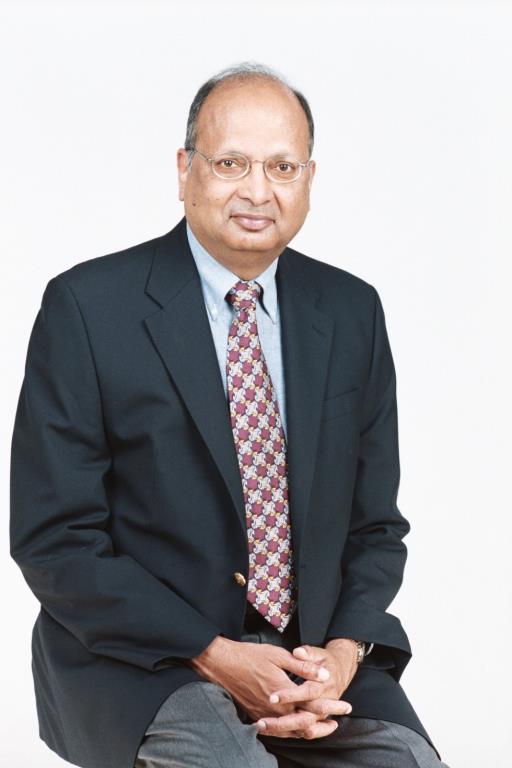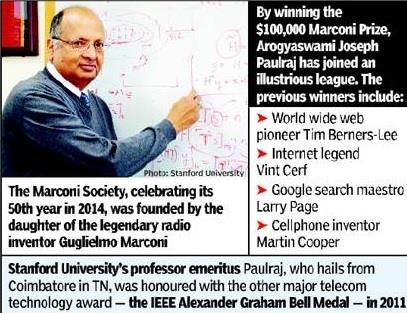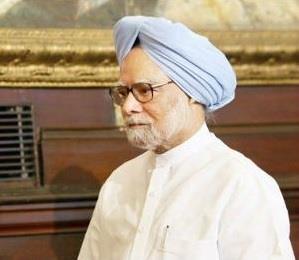January 22, 2014

The Marconi Prize comes just three years after Paulraj was honored with the other major Telecom technology award – the IEEE Alexander Graham Bell Medal for his work on theoretical foundations of MIMO.
January 22, 2014

The Marconi Prize comes just three years after Paulraj was honored with the other major Telecom technology award – the IEEE Alexander Graham Bell Medal for his work on theoretical foundations of MIMO.
WASHINGTON: An India-born engineer-scientist, who was disdained by the Indian system despite his yeoman contribution to the country's naval defense, and whose subsequent work in the United States is at the heart of the current high speed WiFi and 4G mobile systems, has been awarded the 2014 Marconi Prize, a Nobel equivalent for technology pioneers.
Coimbatore-native and Stanford University Professor Emeritus Arogyaswami Joseph Paulraj, simply known as ''Paul'' to his legion of friends and admirers, has been recognized for his work in inventing and advancing MIMO (Multiple Input Multiple Output) technology, a key enabler of wireless broadband services that has revolutionized high speed delivery of multimedia across the world.
The Marconi Prize, whose previous winners include world wide web pioneer Tim Berners-Lee, Internet legend Vint Cerf, Google search maestro Larry Page, and cell phone inventor Martin Cooper, comes with a $ 100,000 prize, but prestige and recognition worth a lot more for these people who are already millionaires. Uncommonly, the Marconi Prize comes just three years after Paulraj was honored with the other major Telecom technology award – the IEEE Alexander Graham Bell Medal for his work on theoretical foundations of MIMO.
''Paul has made profound contributions to wireless technology, and the resulting benefit to mankind is indisputable. Every wifi router and 4G phone today uses MIMO technology pioneered by him,'' says Professor Sir David Payne, Chairman of the Marconi Society and Director of the Optoelectronics Research Centre at the University of Southampton. ''MIMO will soon be pervasive in all wireless devices. Moreover, Paulraj's work has provided fertile ground for thousands of researchers to explore and advance MIMO's potential to enhance wireless spectrum efficiency.''
The Marconi Society, celebrating its 50th year in 2014, was founded by Gioia Marconi Braga, daughter of the legendary radio inventor Guglielmo Marconi. Winners typically include scientists whose mathematical theories and inventions have shaped the Internet and broadband access, public key encryption, Web search, wired and wireless transmission, multimedia publishing, optical fiber and satellite communications.

While Silicon Valley – where Prof Paulraj is already a legend – will exult in recognition of another tech titan, India's Silicon Plateau might yet rue of another genius it let go. An electrical engineer, Paul worked for nearly a quarter century for the Indian Navy before he quit India. In fact, it was the Indian Navy that sent him to IIT Delhi for an M.S program at the instance of Prof P V Indiresan, an influential EE professor who recognized his potential.
The story goes that in 1970, Stanford Prof. Thomas Kailath, a brilliant and influential systems theorist who is himself a Pune-native, visited IIT Delhi to lecture on non-linear estimation. Inspired by Kailath's lectures, Paul went on to make fundamental advances in the area much to the Indian Navy's benefit. In 1971, after the war with Pakistan exposed shortcomings of the Navy's (British origin) sonars leading to the loss of a Naval ship, Paul led a successful project to redesign the sonar adding many new signal processing concepts. Three years later the new technology was widely deployed in the fleet.
''The (Indian) Navy is enormously proud of Paul's many achievements and will remain always indebted for his landmark development of the APSOH sonar,'' Retired Admiral R. H. Tahiliani, former Chief of the Naval Staff, told the Marconi Society on the occasion of the award to Paul.
In fact, Paul's work enabled India to overcome the military export restrictions imposed by the west. In an ironic twist, the Navy allowed him to go to Stanford on a two-year sabbatical, joining his mentor Tom Kailath. He returned to India in 1986 and served as the founding director for three major labs – CAIR (Center for Artificial Intelligence and Robotics), CDAC (Center for Development of Advanced Computing) and CRL (Central Research Labs of Bharat Electronics).
But by 1991, according to the now familiar narrative, bureaucratic battles began to take their toll, and with the consent of the Indian Navy, he returned to the US and Stanford University. ''His departure for Stanford University was a major loss for our country and the circumstances that led to his move may explain why we have so few Nobel Laureates from India,'' Admiral Tahiliani said.
Although Paul and his wife Nirmala live on the Stanford campus, they are frequent visitors to India, which recognized his contribution to the country with a Padma Bhushan award in 2010. He has been a strong proponent for reviving India's telecom technology industry, noting the high cost to the nation for its near total dependence on telecom imports. "It is expensive and it is self-defeating. We should be making our own equipment, we have the talent and the expertise," he lamented in a phone conversation with ToI on Wednesday.
Courtesy: TNN
















































































































